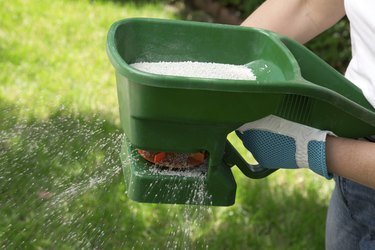
How long fertilizer takes to work in the grass depends on what kind of fertilizer you apply. Slow-release fertilizers provide a small but steady amount of nutrients over a period of six to eight weeks. On the other hand, quick-release fertilizers instantly feed the lawn, and new growth can occur in as little as a day or two.
Tip
If you use a quick-release fertilizer on your lawn, results may be seen within a 24- to 48-hour period and will last two to four weeks. If you use a slow-release fertilizer, it can take several weeks to work.
Video of the Day
Quick-Release vs. Slow-Release Fertilizers
Quick-release fertilizers contain nutrients in their bio-available forms, meaning they can be absorbed by the plant as soon as they make contact with the roots. Quick-release fertilizers are often sold in liquid form to ensure they saturate the soil and reach the roots immediately. Results can be seen within a day or two.
Video of the Day
Slow-release fertilizers contain nutrients in a more complex form, meaning they need to break down in the soil before the plant can absorb them. Commercial slow-release fertilizers are typically sold as granules called prills, which are coated with a substance that slowly dissolves when it comes in contact with water. Results take a little longer to notice.
Homemade Slow- and Quick-Release Fertilizers
You don't necessarily need to purchase slow-release and quick-release synthetic fertilizers. For example, you can create your own compost pile and then rake the aged compost over your lawn for a slow-release organic fertilizer. Leaving grass clippings on your lawn will also slowly release nitrogen and other nutrients back into the lawn.
To make a quick-release fertilizer, soak compost in a 5-gallon bucket of water for about 24 hours to make "compost tea." Scoop out the solid compost and pour the water into a sprayer to distribute it over your lawn.
When to Use Quick-Release Fertilizer
Quick-release fertilizer is ideal to use immediately after seeding a new lawn or overseeding an existing lawn. Thanks to the boost of nutrients, the grass will grow quickly and will have a better chance of outcompeting weeds. Choose a quick-release fertilizer if your lawn is recovering from disease, drought or pests to rapidly increase its health.
When to Use Slow-Release Fertilizer
Despite its advantages, quick-release fertilizer only lasts in the soil for two to four weeks. That means you'll need to apply it consistently for best results. When you don't have the time or the budget to handle such regular applications, choose a slow-release fertilizer.
The nutrients in slow-release fertilizer break down into the soil over a longer period of time (about six to eight weeks), reducing the number of applications required. The slow release balances the lawn's growth, ensuring the roots and blades grow at a similar rate. Relying too much on quick-release fertilizers may result in a weakened root system.
Using a Combination of Both
A mixture of both quick-release and slow-release fertilizers covers all the bases. Just in case you don't keep up with the proper quick-release application schedule, your lawn will continue to receive consistent fertilizer thanks to the slow-release granules. In addition, slow-release fertilizer doesn't work as well in cold weather, so your grass will continue to be fed by quick-release fertilizer when the temperature dips.
You can purchase fertilizer blends that contain coated (slow-release) and noncoated (quick-release) granules to simplify a mixed application.
- Lawn Buddies: Slow-Release vs. Quick-Release Fertilizer: Which One Is Best for Your Lawn?
- The Lawn Institute: Fertilizers – Quick-Release and Slow-Release Nitrogen – What’s the Difference?
- PennState Extension: Turfgrass Fertilization: A Basic Guide for Professional Turfgrass Managers
- Purdue University: Fertilizer Recommendations